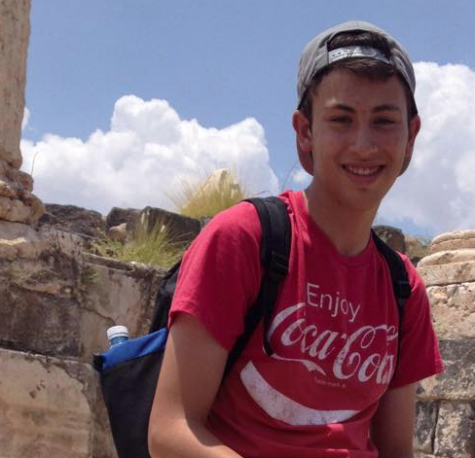Hebrew letters on L.A. walls bring color to street scenes
LAYERS: Jewish-infused mural near Venice Beach is painted on a multi-layered construction of wood.
September 16, 2015
What does a medieval illuminated manuscript have to do with modern street art?
The Illuminated Streets project, conceived and carried out by Shalhevet alumnus Hillel Smith ’02 and Israeli artist Itamar Paloge, is a series of murals based on the art of illuminated manuscripts using Jewish writings, lettering and themes.
The project’s purpose is “to express Jewish identity through unlikely media,” according to its website. Its name revives of the idea of illuminated manuscripts, elaborately decorated books written before the invention of the printing press.
“We thought that was kind of a fitting metaphor — that we’re not making books beautiful, but we’re actually putting the words up in the streets and illuminating them, and we are very literally bringing color into the streets”, said Smith, 30, paintbrush in hand as he worked on an unrelated mural at Westwood Kehilla synagogue.
“Even within the Jewish tradition, if you look at Torah covers, and Aron covers — I thought it was really cool, that we have this Jewish art out of words that goes back hundreds and hundreds of years.”
The idea was born when the two artists met at an Asylum Arts retreat in New York in last March. Founded in 2013, Asylum Arts is an organization based in New York aimed at supporting young Jewish artists.
At the gathering of around 60 Jewish artists, Paloge and Smith looked over each other’s portfolios and realized they had similar interests and styles. Together, they applied for a grant to introduce Jewish content into L.A’s art scene.
At the Silverlake Independent Jewish Community Center, Smith and Paloge painted a giant, vibrant letter Aleph lightly veiled by small blue Hebrew letters, which spread out to cover the rest of the wall.
At the American Jewish University, they painted a quote from Mishlei on a long wall of the student union. In large, blue, angular letters, it announces in Hebrew, “Happy is the person who finds wisdom” — Mishlei 3:13.
The most unique mural of the project is at the Venice Love Shack, an eclectic art and furniture shop near Venice Beach There, the artists created a multi-layered surface of wood and other materials, and on this background painted an amalgam of letters and shapes was painted in blue, gold, and red.
Smith, 30, took AP Studio Art at Shalhevet and went on to study art at Penn.
“He was extremely memorable,” said art teacher Mrs. Roen Salem. “Had extremely good drawing skills, stayed after class, and worked outside the box.”
Paloge, 32, and also known as Faluja, is a street artist in Israel, coloring up underserved neighborhoods. His work has been exhibited at Shodedey Yam gallery and Machane Yehuda in Jerusalem.
Smith says L.A. is artistically significant for two reasons. The entertainment industry brings high caliber creativity to town and with it, high expectations.
In addition, the city’s cultural diversity livens things up.
“In the street art community, a lot of it is tied to where people come from,” says Smith. “Illuminated Streets adds Judaism to the mix.”
With funding from Asylum Arts and the NextGen Engagement Initiative at the Jewish Federation, the pair chose their mural sites based on the effect they hoped to have on neighborhood and audience. The JCC and AJU were a chance to influence the mood of important civic spaces.
“Those two were important, to me at least, because they were big institutions, and we brought a different kind of look at Judaism to these places,” Smith said.
“AJU has a reputation… as a little bit traditional, and we thought this was a great opportunity to bring a way of looking at Jewish life that’s bright and bold and innovative.”
Silver Lake called for a different mood.
“This is a hip neighborhood covered in street art,” Smith said. “The idea here was, here people are surrounded by incredible art everyday, let’s show that art can really have a Jewish bend to it and that Jewish art can fit into this bigger context’”
Ayana’s Morse, executive director of the Silverlake JCC, feels the mural has added a lot to the area.
“People really responded to it from the beginning,” Ms. Morse said. “I think it really changed the face of our entryway. It’s really become part of the center in a really seamless way.”
Josh Feldman, the AJU’s Director of Institute for Jewish Creativity, said the Mishlei mural is popular on campus.
“Students have taken selfies and made it their Facebook profile pictures,” Mr. Feldman said. “Other institutions have been excited about the piece as a demonstration of Jewish mural culture.
To create their murals, the two artists had to create artistic styles they both agreed would represent the messages that were central to the theme of the project. Then they met with the head of each institution to agree on the concept.
Paloge and Smith have different artistic styles, but Smith says that worked to their advantage.
“You can see some of the digital nature reflected particularly in my contributions to it, which is angular, because Itamar works more organically in his art,” Smith said. “His contributions have a lot of a more spontaneous organic look to it and I think the juxtaposition of those two styles works really well.”
Both use Hebrew typography throughout, and Smith believes that lettering is essential to the Jewish nature of their art.
Now that the L.A. project in L.A. has ended, the pair of artists is heading to Israel later this month to start work on part two. Possible locations include Tachana Rishona, a village in the Negev, and Tel Aviv.
Their hope, Smith said, is for the next phase of the project to “Illuminate the streets of [Israeli] communities by infusing them with color and meaning.”
Perhaps that would combine what’s new with what’s most ancient of all.














